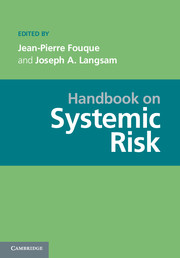Book contents
- Frontmatter
- Contents
- Contributors
- Introduction
- PART I DATA: THE PREREQUISITE FOR MANAGING SYSTEMIC RISK
- PART II STATISTICS AND SYSTEMIC RISK
- PART III MEASURING AND REGULATING SYSTEMIC RISK
- PART IV NETWORKS
- PART V SYSTEMIC RISK ANDMATHEMATICAL FINANCE
- PART VI COUNTERPARTY RISK AND SYSTEMIC RISK
- PART VII ALGORITHMIC TRADING
- PART VIII BEHAVIORAL FINANCE: THE PSYCHOLOGICAL DIMENSION OF SYSTEMIC RISK
- PART IX REGULATION
- PART X COMPUTATIONAL ISSUES AND REQUIREMENTS
- PART XI ACCOUNTING ISSUES
PART VIII - BEHAVIORAL FINANCE: THE PSYCHOLOGICAL DIMENSION OF SYSTEMIC RISK
Published online by Cambridge University Press: 05 June 2013
- Frontmatter
- Contents
- Contributors
- Introduction
- PART I DATA: THE PREREQUISITE FOR MANAGING SYSTEMIC RISK
- PART II STATISTICS AND SYSTEMIC RISK
- PART III MEASURING AND REGULATING SYSTEMIC RISK
- PART IV NETWORKS
- PART V SYSTEMIC RISK ANDMATHEMATICAL FINANCE
- PART VI COUNTERPARTY RISK AND SYSTEMIC RISK
- PART VII ALGORITHMIC TRADING
- PART VIII BEHAVIORAL FINANCE: THE PSYCHOLOGICAL DIMENSION OF SYSTEMIC RISK
- PART IX REGULATION
- PART X COMPUTATIONAL ISSUES AND REQUIREMENTS
- PART XI ACCOUNTING ISSUES
Summary
Behavioral Finance: Introduction
Behavioral finance is the application of psychology to financial decision making and financial markets. This section consists of three chapters whose content provides perspectives and tools to facilitate the integration of psychological variables into the analysis of systemic risk.
FCIC Report
To set the stage for the issues discussed in this part of the Handbook, consider a series of comments made by the Financial Crisis Inquiry Commission (FCIC) in connection with regulatory failures that occurred before and during the financial crisis that erupted in 2008. In its report, the FCIC draws attention to a series of issues that include the mistaking of concentrated risk for diversification, the lack of a comprehensive framework for assessing systemic risk, and the failure to appreciate the role played by the bubble in housing prices. The following series of excerpts, taken from page xxi of the FCIC report, provide the FCIC's perspective.
As our report shows, key policy makers – the Treasury Department, the Federal Reserve Board, and the Federal Reserve Bank of New York – who were best positioned to watch over our markets were ill prepared for the events of 2007 and 2008. Other agencies were also behind the curve. They were hampered because they did not have a clear grasp of the financial system they were charged with overseeing, particularly as it had evolved in the years leading up to the crisis. This was in no small measure due to the lack of transparency in key markets. They thought risk had been diversified when, in fact, it had been concentrated.
- Type
- Chapter
- Information
- Handbook on Systemic Risk , pp. 603 - 621Publisher: Cambridge University PressPrint publication year: 2013

